英语中的限定词
- 格式:docx
- 大小:22.04 KB
- 文档页数:13
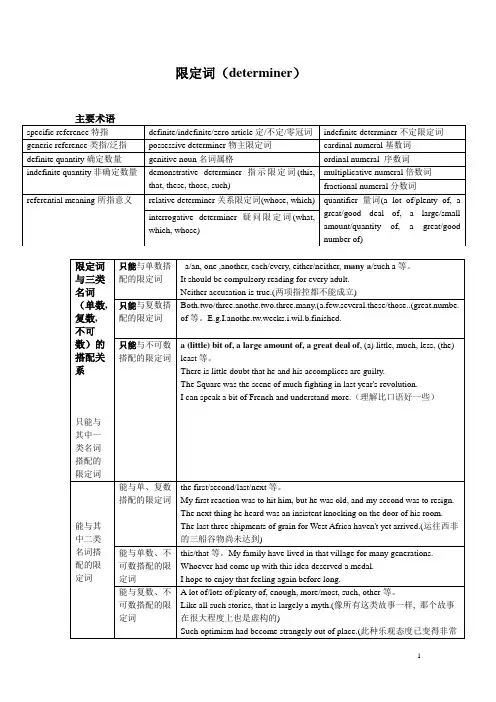
限定词(determiner)限定词的先后顺序: 前位---中位---后位(一个名词中心词之前不可并用两个前位限定词或两个中位限定词)冠词的表意功能(1)The ten of them have passed the final examination.Ten of them have passed the final examination.Ten of the (these/his) students have passed the final examination.(2)They asked to stop counting presidential votes for a second time.(3)Every boy and every girl___(have) his merits.Every young man, young lady,and child ___(be) requested to take part.Many a person___(be) going to the take the test.(4)Other or anotherCalifornia covers a large area than __________state except Alaska and Texas.Out of the three foreign guests, one is from Frankfurt, ______two are from Vienna.. Don'.los.heart.Hav.___try.There's room for _________people in the back of the bus.(5). ing.We'l.hav.____.five-da.holiday.(6)冠词的用法Who is ___captain of your team?. Mr.Reaga.wa.electe.___Presiden.o.th.Unite.State.i.1980.Charles Dickens,__author of David Copperfield, was a distinguished English novelist.As ____physician, he does not deserve much praise.He was covered with snow from ___head to __foot.The relation between ___teacher and ___student is excellent.This room serves the triple purpose of ___study, ___bedroom and ____sitting room. The old man was sitting in a chair, ___pipe in ___hand.He sat at ___ table, ___coat off, ___head down, and __pen in ___hand.What kind of ___man is he?What sort of ___book do you want?The work is ____pleasure to me.She has developed ___love for labour.Physics is ____ science.He spoke with _____ enthusiasm which inspired us all.Do you like ___ music of ___film?Phonetics is ____science of speech sounds。
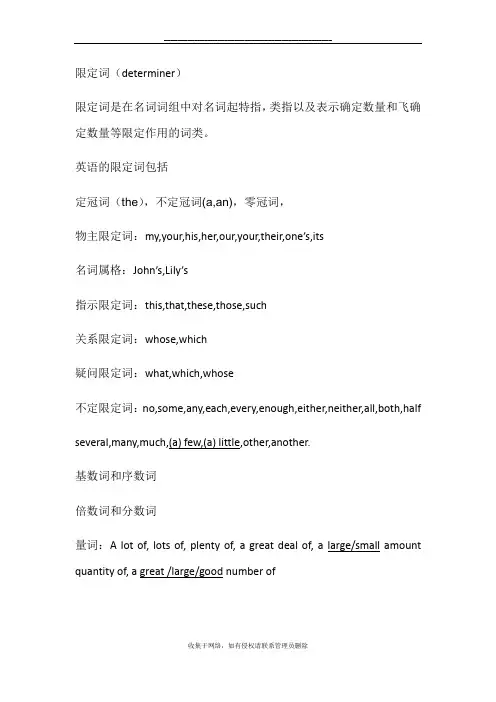
限定词(determiner)限定词是在名词词组中对名词起特指,类指以及表示确定数量和飞确定数量等限定作用的词类。
英语的限定词包括定冠词(the),不定冠词(a,an),零冠词,物主限定词:my,your,his,her,our,your,their,one’s,its名词属格:John’s,Lily’s指示限定词:this,that,these,those,such关系限定词:whose,which疑问限定词:what,which,whose不定限定词:no,some,any,each,every,enough,either,neither,all,both,half several,many,much,(a) few,(a) little,other,another.基数词和序数词倍数词和分数词量词:A lot of, lots of, plenty of, a great deal of, a large/small amount quantity of, a great /large/good number of限定词与三类名词的搭配关系。
(U,C,Plural)能与这三类名词搭配的:The,some,any,no,other,whose以及my,your等物主限定词和名词属格(John’s,my friend’s)I have no time to write to you.It is still unclear whose houses were burnt last night.只能与单数名词搭配的限定词A(an),one, another,each,every,either,neither,many a, such a,etc.He is going to buy another car.只能与复数名词搭配的限定词Both ,two,three,another two/three,many, (a)few , several,these,those,a (great) number of等只能与复数名词搭配。
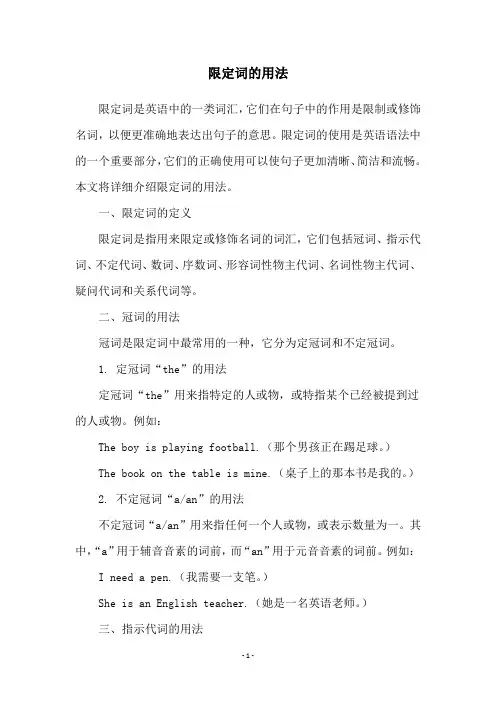
限定词的用法限定词是英语中的一类词汇,它们在句子中的作用是限制或修饰名词,以便更准确地表达出句子的意思。
限定词的使用是英语语法中的一个重要部分,它们的正确使用可以使句子更加清晰、简洁和流畅。
本文将详细介绍限定词的用法。
一、限定词的定义限定词是指用来限定或修饰名词的词汇,它们包括冠词、指示代词、不定代词、数词、序数词、形容词性物主代词、名词性物主代词、疑问代词和关系代词等。
二、冠词的用法冠词是限定词中最常用的一种,它分为定冠词和不定冠词。
1. 定冠词“the”的用法定冠词“the”用来指特定的人或物,或特指某个已经被提到过的人或物。
例如:The boy is playing football.(那个男孩正在踢足球。
)The book on the table is mine.(桌子上的那本书是我的。
) 2. 不定冠词“a/an”的用法不定冠词“a/an”用来指任何一个人或物,或表示数量为一。
其中,“a”用于辅音音素的词前,而“an”用于元音音素的词前。
例如: I need a pen.(我需要一支笔。
)She is an English teacher.(她是一名英语老师。
)三、指示代词的用法指示代词用来指示某个人或物的位置或身份,分为“this”、“that”、“these”和“those”四种。
1. “this”和“that”的用法“this”用来指示离说话人较近的人或物,而“that”用来指示离说话人较远的人或物。
例如:This is my car.(这是我的车。
)That is his book.(那是他的书。
)2. “these”和“those”的用法“these”用来指示离说话人较近的复数人或物,而“those”用来指示离说话人较远的复数人或物。
例如:These are my friends.(这些是我的朋友。
)Those are their bags.(那些是他们的包。
)四、不定代词的用法不定代词用来指代不确定的人或物,包括“some”、“any”、“no”、“none”、“every”、“each”、“either”和“neither”等。
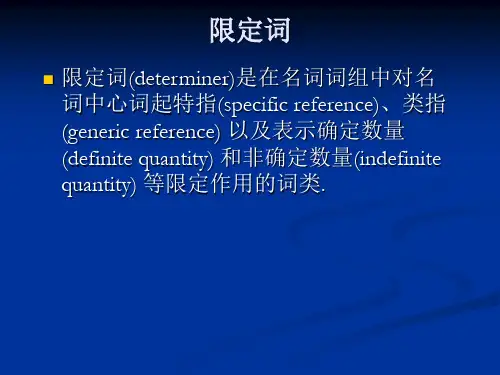
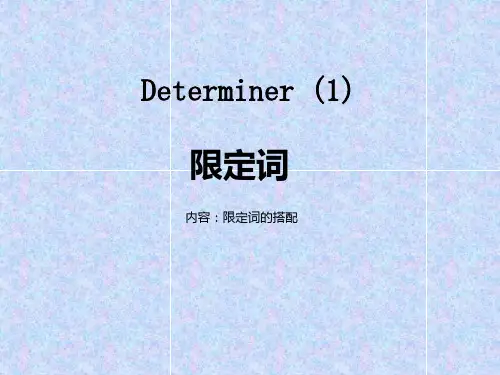
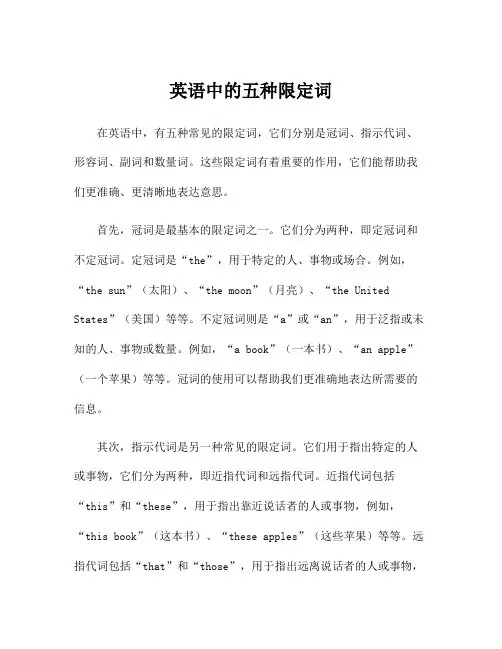
英语中的五种限定词在英语中,有五种常见的限定词,它们分别是冠词、指示代词、形容词、副词和数量词。
这些限定词有着重要的作用,它们能帮助我们更准确、更清晰地表达意思。
首先,冠词是最基本的限定词之一。
它们分为两种,即定冠词和不定冠词。
定冠词是“the”,用于特定的人、事物或场合。
例如,“the sun”(太阳)、“the moon”(月亮)、“the United States”(美国)等等。
不定冠词则是“a”或“an”,用于泛指或未知的人、事物或数量。
例如,“a book”(一本书)、“an apple”(一个苹果)等等。
冠词的使用可以帮助我们更准确地表达所需要的信息。
其次,指示代词是另一种常见的限定词。
它们用于指出特定的人或事物,它们分为两种,即近指代词和远指代词。
近指代词包括“this”和“these”,用于指出靠近说话者的人或事物,例如,“this book”(这本书)、“these apples”(这些苹果)等等。
远指代词包括“that”和“those”,用于指出远离说话者的人或事物,例如,“that house”(那栋房子)、“those mountains”(那些山)等等。
指示代词的使用可以帮助我们在交流中更加清晰。
第三,形容词是一种用于描述名词的限定词。
它们可以用来描述人、事物、地点等等。
形容词的作用是让描述更加详细、准确。
例如,“beautiful”(美丽的)、“spacious”(宽敞的)等等。
形容词的使用可以让我们更加生动地描绘所描述的对象。
第四,副词也是一种常见的限定词。
与形容词不同,它们用于描述动词、形容词、另一个副词或整个句子的词。
它们可以用来表达时间、地点、方式等等,例如,“slowly”(缓慢地)、“quickly”(快速地)、“here”(这里)等等。
副词的使用可以让我们更加清晰地描述行为或状态。
最后,数量词是用于描述数量或数字的限定词。
它们可以用于描述数量,例如,“one”(1)、“two”(2)等等。

英语限定词及分类■按照限定词与限定词的相互搭配关系,限定词可分为前位限定词(pre-determiner)、中位限定词(central determiner)和后位限定词(post-determiner)。
■限定词的相互搭配关系为:前位+中位+后位■在这三类限定词中,前位限定词与前位限定词以及中位限定词与中位限定词是相互排斥的,后位限定词与后位限定词之间虽不相互排斥但有搭配限制。
■前位限定词包括:all, both, half; double, twice, three times, etc; one-third, two-fifths, etc; what, such, (a / an)等。
■中位限定词包括:冠词:a(n), the指示代词:this, that, these, those形容词性物主代词:my, your, his, her, our, etc名词属格:Jim’s, my mother’s不定代词:some, any, no, every, each, either, neither, enough, etc连接代词what(ever), which(ever), whose, etc■后位限定词包括:one, two, three, etc; first, second, third, etc; next, last, other, another, etc; many, much, (a) few, (a) little, fewer, (the) fewest, less, (the) least, more, most; several, plenty of, a lot of, lots of, a great / large / good number of, a great / good deal of, a large / small amount of; such等。
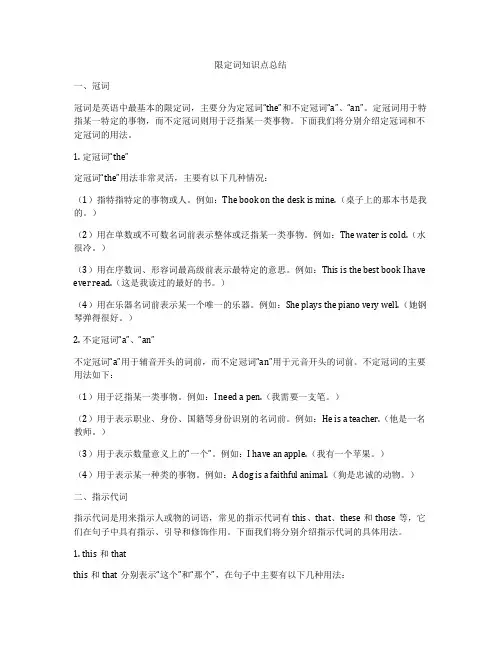
限定词知识点总结一、冠词冠词是英语中最基本的限定词,主要分为定冠词“the”和不定冠词“a”、“an”。
定冠词用于特指某一特定的事物,而不定冠词则用于泛指某一类事物。
下面我们将分别介绍定冠词和不定冠词的用法。
1. 定冠词“the”定冠词“the”用法非常灵活,主要有以下几种情况:(1)指特指特定的事物或人。
例如:The book on the desk is mine.(桌子上的那本书是我的。
)(2)用在单数或不可数名词前表示整体或泛指某一类事物。
例如:The water is cold.(水很冷。
)(3)用在序数词、形容词最高级前表示最特定的意思。
例如:This is the best book I have ever read.(这是我读过的最好的书。
)(4)用在乐器名词前表示某一个唯一的乐器。
例如:She plays the piano very well.(她钢琴弹得很好。
)2. 不定冠词“a”、“an”不定冠词“a”用于辅音开头的词前,而不定冠词“an”用于元音开头的词前。
不定冠词的主要用法如下:(1)用于泛指某一类事物。
例如:I need a pen.(我需要一支笔。
)(2)用于表示职业、身份、国籍等身份识别的名词前。
例如:He is a teacher.(他是一名教师。
)(3)用于表示数量意义上的“一个”。
例如:I have an apple.(我有一个苹果。
)(4)用于表示某一种类的事物。
例如:A dog is a faithful animal.(狗是忠诚的动物。
)二、指示代词指示代词是用来指示人或物的词语,常见的指示代词有this、that、these和those等,它们在句子中具有指示、引导和修饰作用。
下面我们将分别介绍指示代词的具体用法。
1. this和thatthis和that分别表示“这个”和“那个”,在句子中主要有以下几种用法:(1)用于指示近处或者说话者手中的事物。

限定词限定词(DETERMINER〕是在名词词组中对名词中心词起特指(SPECIFIC REFERENCE〕、类指(GENERIC REF ERENCE〕以及表示确定数量(DEFINITE QUANTITY〕和非确定数量(INDEFINITE QUANTITY〕等限定作用的词类。
名词词组除有词汇意义外,还有其所指意义(REFERENTIAL MEANING〕,是特指(即指特写的对象〕,还是类指(即泛指一类人或物〕;是有确定的数量,还是没有确定的数量。
能在名词词组中表示这种所指意义的词类就是限定词。
英语的限定词包括:定冠词(DEFINTITE ARTICLE〕,不定冠词(INDEFINITE ARTICLE〕,零冠词(ZERO ARTICLE〕物主限定词(POSSESSIVE DETERMINER〕,my, your, his, her, our, your, their, one’s, its.名词属格(GENITIVE NOUN〕,John’s, my friend’s.指示限定词(DEMONSTRATIVE DETERMINER〕,this, that, these, those, such.关系限定词(RELATIVE DETERRMINER〕,whose, which.疑问限定词(INTERROGATIVE DETERMINER〕,what, which, whose.不定限定词(INDEFINITE DETERMINER〕,no, some, any, each, every, enough, either, neither, all, both, h alf, several, many, much, (a) few, (a) little, other, another.基数词(CARDINAL NUMERAL〕和序数词(ORDINAL NUMERAL〕倍数词(MULTIPLICATIVE NUMERAL〕和分数词(FRACTIONAL NUMERAL〕量词(QUANTIFIER〕a lot of, lots of, plenty of, a great of, a good deal of, a large of, a small amount of, a quantity of, a great of, a good number of等。
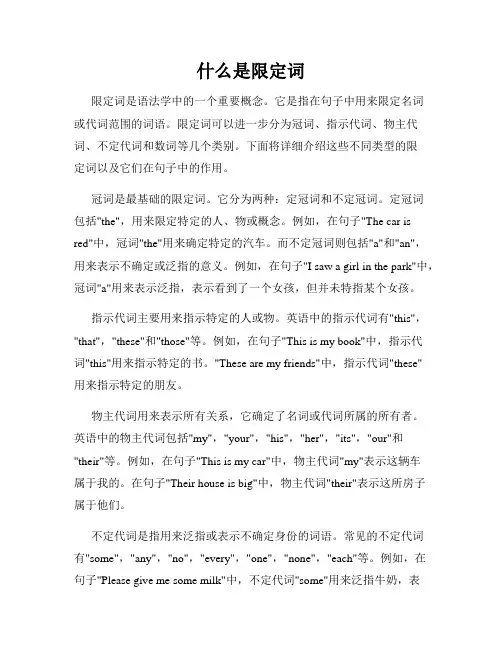
什么是限定词限定词是语法学中的一个重要概念。
它是指在句子中用来限定名词或代词范围的词语。
限定词可以进一步分为冠词、指示代词、物主代词、不定代词和数词等几个类别。
下面将详细介绍这些不同类型的限定词以及它们在句子中的作用。
冠词是最基础的限定词。
它分为两种:定冠词和不定冠词。
定冠词包括"the",用来限定特定的人、物或概念。
例如,在句子"The car is red"中,冠词"the"用来确定特定的汽车。
而不定冠词则包括"a"和"an",用来表示不确定或泛指的意义。
例如,在句子"I saw a girl in the park"中,冠词"a"用来表示泛指,表示看到了一个女孩,但并未特指某个女孩。
指示代词主要用来指示特定的人或物。
英语中的指示代词有"this","that","these"和"those"等。
例如,在句子"This is my book"中,指示代词"this"用来指示特定的书。
"These are my friends"中,指示代词"these"用来指示特定的朋友。
物主代词用来表示所有关系,它确定了名词或代词所属的所有者。
英语中的物主代词包括"my","your","his","her","its","our"和"their"等。
例如,在句子"This is my car"中,物主代词"my"表示这辆车属于我的。
在句子"Their house is big"中,物主代词"their"表示这所房子属于他们。
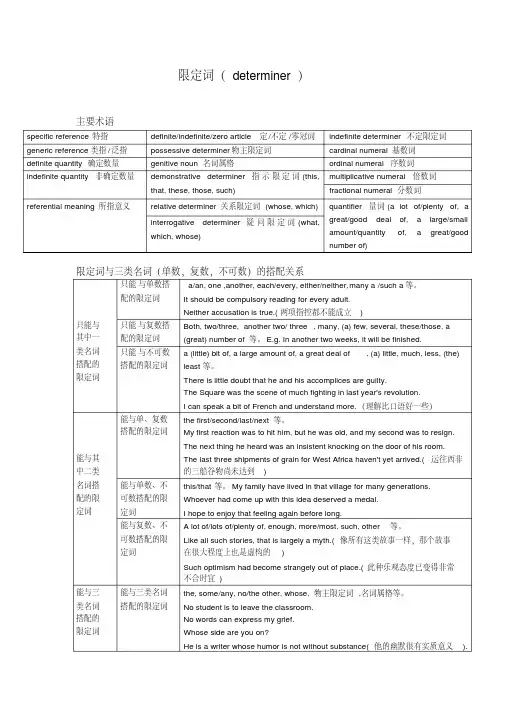
限定词的分类前位限定词1 不定限定词all,both,half2 表示倍数或分数的词double,twice,three times;one-third,two-thirds等3 指示限定词such(与不定冠词连用):与中位限定词a/an或后位限定词a lot of 等连用时4 疑问或连接限定词what(只用于感叹句中)5 不定限定词1 修饰复数可数名词(a) few of, many of, a good/great many of, a (great/large/good/small) number of, etc.2 修饰不可数名词a bit of, (a) little of, much of, a great/good deal of, a great amount of, etc.3 修饰复数可数名词与不可数名词most of, a lot of, lots of, plenty of, a quantity of, etc.上述不定量限定词只有后跟中位限定词the, my, his, her, your, etc., this, that, these, those时用作前位限定词中位限定词1 冠词a/an, the2 物主限定词my,your,his,her,its,our,your,their3 指示限定词this,that,these,those4 不定限定词1 通用限定词each,every2 肯定限定词some3 非肯定限定词any,either4 否定限定词no,neither5 量词限定词enough5 名词所有格——名词+-'s6 疑问限定词/连接限定词/关系限定词 what(ever),which(ever),whose,whosever后位限定词1 序数词 first,second,third,etc.2 通用序数词 last,next,additional,further,past,etc.3 基数词 one,two,three,etc.4 不定限定词1修饰复数可数名词(a)few (of), fewer, (the) fewest, many (of), several2修饰不可数名词(a) little (of), much (of)3修饰不可数名词和复数名词less, more(of),most(of)4修饰单数可数名词和不可数名词(the)least5修饰单、复数可数名词another,certain6 修饰单、复数可数名词及不可数名词other5 开放性量词1修饰复数可数名词a good/great many (of), a (great/large/good/small) number of, etc.2修饰不可数名词a bit of, a great/good deal of, a great amount of, etc.3修饰复数可数名词与不可数名词a lot of, lots of, plenty of, a quantity of, etc.6 指示限定词such(不与冠词连用)限定词与名词的搭配关系A 只修饰单数可数名词的限定词前位限定词what a;中位限定词a/an, each, every, either, neither;后位限定词many a, one, etc.B 只修饰复数可数名词的限定词前位限定词both后位限定词two,three,etc.,(a) few, fewer, (the) fewest, many, several, these, those.前位限定词或后位限定词a good/great many (of), a (great/good/small) number of, etc.C 只能与不可数名词连用的后位(或前位)限定词(a)bit of, a good deal of, a great deal of, a great amount of, (great/large) amounts of, (a) little (of), much (of) D 只与单数和复数可数名词连用的后位限定词first, second, third, etc., last, next, another, (a) certain, etc.E 只与不可数名词和复数可数名词连用的限定词中位限定词enough, 零冠词后位限定词less, more, most, a lot of, lots of, plenty of, a quantity ofF 只与单数可数名词及不可数名词连用的限定词中位限定词this, that后位限定词(the) leastG可与单、复数可数名词及不可数名词连用的限定词前位限定词all, half, double, twice, three times, one-third, two-thirds, such中位限定词the, my, your, etc., some, any, either, no, what(ever), which(ever), whose, whosever, 名词所有格后位限定词additional, further, past, other, such代词分类表。
限定词(determiner)限定词是在名词词组中对名词起特指,类指以及表示确定数量和飞确定数量等限定作用的词类。
英语的限定词包括定冠词(the),不定冠词(a,an),零冠词,物主限定词:my,your,his,her,our,your,their,one’s,its名词属格:John’s,Lily’s指示限定词:this,that,these,those,such关系限定词:whose,which疑问限定词:what,which,whose不定限定词:no,some,any,each,every,enough,either,neither,all,both,half several,many,much,(a) few,(a) little,other,another.基数词和序数词倍数词和分数词量词:A lot of, lots of, plenty of, a great deal of, a large/small amount quantity of, a great /large/good number of限定词与三类名词的搭配关系。
(U,C,Plural)能与这三类名词搭配的:The,some,any,no,other,whose以及my,your等物主限定词和名词属格(John’s,my friend’s)I have no time to write to you.It is still unclear whose houses were burnt last night.只能与单数名词搭配的限定词A(an),one, another,each,every,either,neither,many a, such a,etc.He is going to buy another car.只能与复数名词搭配的限定词Both ,two,three,another two/three,many, (a)few , several,these,those,a (great) number of等只能与复数名词搭配。
限定词( determiner)限定词是在名词词组中对名词中心词起特指、泛指、定量或不定量等限定作用的一类词。
一、英语限定词种类1. 定冠词,不定冠词,零冠词。
如: the, a2. 名词属格。
女口: my friend ' s, Tom s …3. 物主限定词。
如:my, your…4. 指示限定词。
如: this, that, these, those, such …5. 疑问限定词。
如: what, whose, which …6. 关系限定词。
如: which, whose …7. 不定限定词。
如: some, any, each, every, either, neither, all8. 数词 (基数词、序数词、倍数词、分数词 )9. 量词。
如: a lot of, lots of , a great/good deal of ,a great/large/good number of二、限定词与三类名词的搭配关系限定词按它词汇意义可分为特指限定词、泛指限定词、定量限定词、不定量限定词四大类。
这四类限定词有的能与单数、复数可数名词搭配,也可与不可数名词搭配1) 能与三类名词搭配的限定词主要有the; my, John ' s, the old man ' s…;some, any, no, all, other, such, what ( ever ), which (ever), whoseeg. the book - the books ------ the money,my book ---- my books -- my moneyJohn ' s book--- John ' s books -- John 's money2) 能与单数名词搭配的限定词。
如 :a (n) , each, every, another, either ,one, neither, many a, such a(n) …eg. each worker , every student ,either book ,another book3) 能与复数名词搭配的限定词。
英语中的定词定词是英语中一种重要的词汇手段,它用于修饰名词,使其具有特定的含义。
在英语写作中,正确使用定词能够使文章更加精确、清晰,有助于表达作者的意图。
本文将介绍英语中定词的概念、种类、使用技巧以及在写作中的应用,为广大英语学习者提供实用的指导。
1.定词的概念与作用定词,又称限定词,是用来限制或确定名词所指对象数量的词语。
它位于名词之前,起到修饰和限定名词的作用。
常见的定词有:a、an、the、my、your、his、her、its、this、that、these、those等。
通过使用定词,我们可以明确名词所指的对象,避免歧义。
2.英语中定词的种类英语中的定词可分为以下几类:(1)冠词:包括定冠词the和零冠词(无需冠词的情况)。
(2)物主代词:表示某人或某物的,如my、your、his、her、its等。
(3)指示代词:表示近处或远处的事物,如this、that、these、those 等。
(4)疑问代词:用于提问,如which、what、who等。
3.定词的使用技巧在使用定词时,应注意以下几点:(1)根据名词的特定性选择合适的定词。
如果名词具有唯一性,可用定冠词the;如果不具有唯一性,可用零冠词。
(2)在多人或事物并列时,可用物主代词或指示代词区分。
(3)疑问代词用于提问时,需根据语境选择合适的定词。
4.定词在英语写作中的应用在英语写作中,正确使用定词能使文章更具可读性。
以下是一个例子:Badminton is a popular sport in our country.(羽毛球在我们国家是一项流行的运动。
)在此句中,定词“our”限定了“country”的范围,使句子更加明确。
5.提高定词使用水平的建议要提高定词使用水平,可以采取以下方法:(1)多读英语文章,观察优秀作家如何使用定词。
(2)练习写作,有意识地使用定词,并注意检查是否恰当。
(3)学习英语语法,掌握定词的用法和规律。
总之,英语中的定词是写作中不可或缺的元素。
限定词限定词(DETERMINER〕是在名词词组中对名词中心词起特指(SPECIFIC REFERENCE〕、类指(GENERIC REFERENCE〕以及表示确定数量(DEFINITE QUANTITY〕和非确定数量(INDEFINITE QUANTITY〕等限定作用的词类.名词词组除有词汇意义外,还有其所指意义(REFERENTIAL MEANING〕,是特指(即指特写的对象〕,还是类指(即泛指一类人或物〕;是有确定的数量,还是没有确定的数量.能在名词词组中表示这种所指意义的词类就是限定词.英语的限定词包括:定冠词(DEFINTITE ARTICLE〕,不定冠词(INDEFINITE ARTICLE〕,零冠词(ZERO ARTICLE〕物主限定词(POSSESSIVE DETERMINER〕,my, your, his, her, our, your, their, one's, its.名词属格(GENITIVE NOUN〕,John's, my friend's.指示限定词(DEMONSTRATIVE DETERMINER〕,this, that, these, those, such.关系限定词(RELATIVE DETERRMINER〕,whose, which.疑问限定词(INTERROGATIVE DETERMINER〕,what, which, whose.不定限定词(INDEFINITE DETERMINER〕,no, some, any, each, every, enough, either, neither, all, both, half, several, many, much, (a) few, (a) little, other, another.基数词(CARDINAL NUMERAL〕和序数词(ORDINAL NUMERAL〕倍数词(MULTIPLICATIVE NUMERAL〕和分数词(FRACTIONAL NUMERAL〕量词(QUANTIFIER〕a lot of, lots of, plenty of, a great of, a good deal of, a large of, a small amount of, a quantity of, a great of, a good number of等.限定词与名词词组中心词之间有着某种固定的搭配关系;如果名词之前带有两个或两个以上的限定词,则限定词与限定词之间也有某种固定的搭配关系.本讲主要解决这两种搭配关系问题.1 限定词与三类名词的搭配关系限定词的选择决定于随后的名词的类别,是单数名词、复数名词,还是不可数名词.1〕能与三类名词搭配的限定词有些限定词如the, some, any, no, other, whose以及my, your等物主限定词和名词属格(John's, my friend's〕等能与三类名词搭配.例如:the book, my book, my friend's book, John's book, any book, some book, no book, the other book, whose book, the books,my books, my friend's book, John's books, any books, some books, no books, the other books, whose books, the money, my money, my friend's money, John's money, any money,some money, no money, the other money, whose money.2〕只能与单数名词搭配的限定词有些限定词如a(n), one, another, each, every, either, neither, many a, such a 等只能与单数名词搭配.例如:each worker, either book, an apple, another book, such a book, every student, neither sentence, one copy, many a book.3) 只能与复数名词搭配的限定词有些限定词如both, two, three, another two / three, many, (a) few, several, these, those, a (great) number of等只能与复数名词搭配.例如:both workers, several students, a number of essays, many students, (a) fewwords, these / those books, two / three visitors, another two / three students.4) 只能与不可数名词搭配的限定词有些限定词如a (little) bit of, a great amount of, a great deal of, (a) little, much 等只能与不可数名词搭配.例如:a bit of water, a great amount of labour, a great deal of work, (a) little space, much noise.5〕能与单、复数名词搭配的限定词有些限定词如the first, the second, the last, the next等既可与单数名词搭配,也可与复数名词搭配.例如:the first rose, the last man, the next meeting, the first roses, the last men, the next meetings.6〕能与单数名词和不可数名词搭配的限定词有些限定词如this, that, (the) least等能与单数名词和不可数名词搭配.例如:(the) least sign (of prejudice), this / that job, (the) least knowledge, this / that work.7〕能与复数名词和不可数名词搭配的限定词还有些限定词如a lot of, lots of, enough, more, most, such, other等可与复数名词和不可数名词搭配.例如:a lot of books, a lot of money, lots of chickens, lots of food, plenty of chairs, plenty of water, enough copies, enough coal, more articles, more time, most people, most work, such men, such bread, other men, other bread.不定量限定词less原先只与不可数名词搭配,但在现代英语中,less既可与不可数名词也可与复数名词搭配.例如:less money, less mistakes.2 限定词与限定词的搭配关系以上讲的是限定词与三类名词的搭配关系.除上述搭配关系外,限定词与限定词之间还存在着一定的搭配关系.在名词词组中心词之前如果有两个或两个以上限定词出现时,就会产生限定词的先后顺序问题.按其不同的搭配位置,限定词可分为:1〕中位、前位、后位限定词按照限定词与限定词之间不同搭配位置,限定词可分为中位限定词(CENTRAL DETERMINER〕、前位限定词(PREDETERMINER〕和后位限定词(POSTDETERMINER〕.a) 中位限定词包括a(n), the, zero; this, that, these, those; my, your, etc; Merry's, my friend's; some, any, no, every, each, either, neither, enough; what(ever), which(ever), whose等b) 前位限定词包括all, both, half; double, twice, three times, etc; one-third, two-fifths, etc; what, such, (a / an)等c) 后位限定词包括one, two, three, etc; first, second, third, etc; next, last, other, another, etc; many, much, (a) few, (a) little, fewer, (the) fewest, less, (the) least, more, most; several, plenty of, a lot of, lots of, a great / large / good number of, a great / good deal of, a large / small amount of; such等2) 三类限定词的搭配关系如果一个名词词组带有上述三类限定词,其搭配关系总是按照"前位--中位--后位"的顺序排列.例如:all前the中four后teachers.all前your中three后books.all前these中last后few后days.如果只有上述两类限定词,其搭配关系仍按上述顺序.例如:half前his中lecture.those中last后few后months.several后hundred后guests.all前other后students.such前a中misfortune.some中such后alloy.由上述诸例可以看出,中位限定词之间和前位限定词之间是互相排拆的,即一个名词中心词之前不可并用两个中位限定词或两个前位限定词.所以,"我的那本书"不是* my that book 而是that book of mine,因为my和that同是中位限定词,不可同时并列.但后位限定词的使用却不受此限.除上述those last few months, several hundred guests之外, this last two books, the first two chapters, three other girls, two more sheets, the next few weeks, many more copies, a few more samples, another twenty tons 等都是后位限定词重叠使用的实例.个别限定词有跨类现象,如such既属于前位限定词,又可归入后位限定词.由于它只是在such a...和such an...这样的搭配中属于前位限定词,而在与其他限定词(some, any, no, all, few, another, other, many, one, two, etc)搭配时,such则是后位限定词,一律放在上述这些限定词的后面,如some such, any such, nosuch, few such, one such等。